Chestnut Resources
Chestnut trees are any of the seven or more species belonging to the genus Castanea which are native to humid temperate climates in mountainous regions of the northern hemisphere. Many of the species are large trees and are (or were) important components of upland forest ecosystems. All species produce sweet, edible nuts, that are high in carbohydrates and low in fat – more grain-like than nut-like. Chestnuts have been important food sources for wildlife, livestock, and humans. Three species of chestnut, namely the Chinese, Japanese, and European have been cultivated as tree crops for thousands of years. All species of chestnut are closely related; they can readily hybridize and produce fertile offspring. Consequently, there now exist lots of hybrid chestnuts with two or more species in their ancestry. This often makes species identification difficult and confusing.
Chestnuts are NOT related to horse chestnuts (buckeyes) belonging to the genus Aesculus, which are poisonous, nor to water chestnuts, which are tropical vegetables.
The four main species of chestnuts are the American (Castanea dentata), the Chinese (C. mollissima), the European (C. sativa), and the Japanese (C. crenata). “Korean” chestnuts are Japanese or Chinese/Japanese hybrids but have characteristics that distinguish them from chestnuts native to Japan or China. Three minor species of chestnut are the American chinkapin (C. pumila and others), the Seguin (C. seguinii) and the Chinese chinkapin (C. henryi). The species called “chestnuts” characteristically bear 3 nuts inside spiny burs, while the species called “chinkapins” usually bear one nut per bur. Within all chestnut species there is tremendous genetic variation, especially in the Chinese, European, and Japanese species, which are somewhat domesticated. The variation within species may be greater than the variation between species. Nevertheless, there are some general characteristics of species that are distinguishing and noteworthy.
The American chestnut is (was) a tall, straight canopy dominant forest tree in eastern North America, valued as a timber tree as much as a nut producing tree. The nuts tend to be small, but easy-to-peel and exquisitely flavored. At the northern extent of its range, the trees are very cold hardy. On the downside, American chestnuts are very susceptible to chestnut blight and phytophthora root rot. These disease susceptibilities have essentially removed the tree’s ecological and economic importance, but enough of the species’ population remains that it can be utilized in breeding – either to create disease resistant American-type chestnuts or to incorporate American characteristics into hybrids.
The Chinese chestnut, native to China, is the most genetically diverse species and may be considered the progenitor species from which all other species were derived. It is generally a branchy, medium-sized tree, ultimately attaining about 2/3 the height of the American chestnut, but it does vary considerably in in its growth habit. Its nuts vary in size from small to large and are generally easy peeling and quite tasty with bright yellow kernels. The species has broad climatic adaptation and disease resistance. It is well-adapted to growing conditions and disease pressures in eastern North America and is well-liked by consumers.
The Japanese chestnut, native to Japan and the Korean peninsula, is a medium to large-sized tree with some individuals growing faster and taller than Chinese chestnuts, but still shorter than American chestnuts. Its nuts range to a very large size, but generally are difficult-to-peel and have a bland flavor, with some individuals tasting bitter or astringent. The kernels are generally white or cream-colored. The species tends to be vigorous, precocious and high yielding with disease resistance comparable to Chinese chestnuts. It has broad climatic adaptation with some individuals exhibiting more cold hardiness and cool growing season tolerance than Chinese chestnuts.
The European chestnut, native to southern Europe and Asia Minor, is a large-sized tree with a reputation for longevity. It is cultivated for both timber and nuts. The nuts are medium to large size with whitish kernels, and some are difficult to peel. Flavor is variable with some cultivars quite tasty, better cooked than raw. European chestnuts are susceptible to chestnut blight and phytophthora, and most are not very cold hardy. They seem to thrive in Mediterranean-type climates, and consequently, do well in the west coast states of the USA and in southwestern British Columbia. In Europe and in western USA, there are now many cultivars that are European-Japanese hybrids. These hybrids tend to have larger nut size, higher productivity, and higher disease resistance, but with diminished flavor and peeling characteristics.
The North American chinkapins are a genetically diverse group, which some taxonomists have divided into 2 or more species. The two commonly recognized groups are the Allegheny chinkapin native to southeastern USA and the Ozark chinkapin native to the Ozark plateau but with populations scattered across the southeastern states. Chinkapins are shrubs to medium sized trees and are characterized by bearing very small nuts, one per bur. The nuts are tasty, but their tiny size render them difficult to harvest and eat. They are a premier wildlife food, especially for birds like blue jays and turkeys. They are susceptible to chestnut blight and phytophthora.
The Chinese chinkapin is native to southern China and is a large tree characterized by bearing one nut per bur. It has not been widely cultivated outside of China. It is not very cold hardy.
The Seguin chestnut, native to the southern part of the chestnut range in China, is a medium-sized tree. It bears small nuts, 3 per bur. Its unusual characteristic is that some individuals are ever-flowering; i.e., they continuously flower during the summer thus bearing nuts that ripen over a long period of time in the fall. It is not grown commercially and is little known.
Generally, in eastern North America, the Chinese chestnut has been found to exhibit the best climate adaptation combined with disease resistance. On the west coast, European or European-Japanese hybrids seem to do better. However, these generalizations are not strict, and there are efforts to combine the superior nut qualities of the Chinese species with the superior growth and yield qualities of the European and Japanese species across many environments. And, there are unique and desirable qualities of the American species and chinkapins that are also being put into hybrids. So, when choosing chestnut trees to plant, they should be chosen based on their characteristics and local adaptation, and not so much on their species or “purity”.
Chestnuts are pickier about site than most other nut trees. They require a well-drained, acidic soil and full sun. Rocks are okay. Deep soils are preferred because of their water-storage capacity. Chestnuts do best on slopes, even steep slopes. However, steep slopes make it difficult to care for the trees and harvest the crop. Most chestnut planting failures are due to soils being too wet, too heavy, or too alkaline. Many soils that are suitable for agronomic crops are unsuitable for chestnuts.
Chestnut trees, like other fruit and nut trees, are sensitive to late spring frosts, and therefore, should be planted on hilltops, near large bodies of water, or other frost-protected sites. Chestnuts are very drought tolerant on good (deep soil) sites. However, to grow well, bear consistent crops, and bear large-sized nuts, they need adequate moisture throughout the growing season. Irrigation is not required in much of eastern North America, but it is beneficial for consistent high yields of large sized chestnuts.
Chestnuts will grow over a broad climatic range from USDA plant hardiness zones 4 to 8 and seem to do best in areas that have hot, humid summers. There is great genetic variation in climatic tolerance, esp. cold hardiness, so you need to choose trees adapted to your climate. Unfortunately, chestnuts have not yet been tested extensively enough in North America that we know which trees are best suited for any particular area. So, it’s a good idea to plant trees from a climate that is similar to the climate where they are being planted.
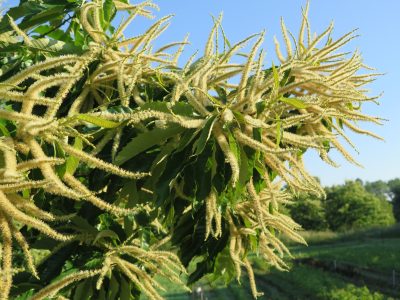 Chestnuts require cross-pollination to set nuts, so you’ll need two or more trees, or two or more cultivars if you plant grafted trees. Chestnuts generally have both male and female flowers, so all trees will bear nuts and usually can pollenize each other. However, some hybrids are male sterile which means they bear nuts but cannot pollenize other trees.
Chestnuts require cross-pollination to set nuts, so you’ll need two or more trees, or two or more cultivars if you plant grafted trees. Chestnuts generally have both male and female flowers, so all trees will bear nuts and usually can pollenize each other. However, some hybrids are male sterile which means they bear nuts but cannot pollenize other trees.- Chestnuts drop sharp, spiny burs on the ground whose sharp spines endure for more than a year. This can be a problem if the trees are sharing space with people.
- There is a large, unsatisfied demand for chestnuts and prices are high.
- When chestnuts fall from the tree, they are about 50% water. Unlike other nuts, they must be stored and marketed in this high moisture condition. Consequently, they are highly perishable and must be promptly harvested then refrigerated for storage longer than a week. In other words, chestnuts are handled more like fruit than like other nuts.
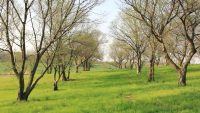 When in full production, chestnuts will yield 1,000 to 4,000 lb per acre. Depending on how they are marketed, prices range from $1.50 to $6.00 per lb. One to five acres is a manageable size that one or two people could care for by hand and net a few thousand dollars. Plantings larger than five acres will require more equipment or more labor than one or two people can provide, at least during harvest. To economically justify cleaning, sizing, and sorting equipment, as well as cold storage and marketing, it is necessary to have at least 50 acres in production, preferably more. Combining production from several or more growers in the form of a marketing cooperative is a viable way to achieve the necessary economies of scale.
When in full production, chestnuts will yield 1,000 to 4,000 lb per acre. Depending on how they are marketed, prices range from $1.50 to $6.00 per lb. One to five acres is a manageable size that one or two people could care for by hand and net a few thousand dollars. Plantings larger than five acres will require more equipment or more labor than one or two people can provide, at least during harvest. To economically justify cleaning, sizing, and sorting equipment, as well as cold storage and marketing, it is necessary to have at least 50 acres in production, preferably more. Combining production from several or more growers in the form of a marketing cooperative is a viable way to achieve the necessary economies of scale.
 The chestnut species best suited for nut production in eastern North America is the Chinese chestnut, in terms of climatic adaptation, nut quality, and marketability. It is sweet, easy-to-peel, and blight resistant. Either seedlings or grafted trees can be planted, and there is debate over which is better. (A seedling is a tree derived from planting a nut; seedlings are all genetically different from each other. A grafted tree is made by placing a bud (scion) from a known cultivar onto a seedling rootstock; grafting is a method of cloning.) Seedlings are more vigorous and more forgiving with respect to care and site. Grafted trees have more predictable characteristics, are slower growing, and bear at a younger age, but they exhibit a high rate of mortality, especially when stressed. Presently, seedling orchards derived from good parents have proven more successful than orchards of grafted trees mainly due to the high mortality and slower growth of grafted trees. Furthermore, seedlings from highly selected diverse parents often outperform grafted cultivars in terms of yield and nut quality. The seedlings that are available now are much better than those available a decade or two ago. Just be careful to plant the right ones. The preference for seedling orchards applies only to Chinese chestnuts. European, Japanese, and European-Japanese hybrids tend to graft better and not have as high a frequency of good offspring. So, for these, the balance favors grafted orchards.
The chestnut species best suited for nut production in eastern North America is the Chinese chestnut, in terms of climatic adaptation, nut quality, and marketability. It is sweet, easy-to-peel, and blight resistant. Either seedlings or grafted trees can be planted, and there is debate over which is better. (A seedling is a tree derived from planting a nut; seedlings are all genetically different from each other. A grafted tree is made by placing a bud (scion) from a known cultivar onto a seedling rootstock; grafting is a method of cloning.) Seedlings are more vigorous and more forgiving with respect to care and site. Grafted trees have more predictable characteristics, are slower growing, and bear at a younger age, but they exhibit a high rate of mortality, especially when stressed. Presently, seedling orchards derived from good parents have proven more successful than orchards of grafted trees mainly due to the high mortality and slower growth of grafted trees. Furthermore, seedlings from highly selected diverse parents often outperform grafted cultivars in terms of yield and nut quality. The seedlings that are available now are much better than those available a decade or two ago. Just be careful to plant the right ones. The preference for seedling orchards applies only to Chinese chestnuts. European, Japanese, and European-Japanese hybrids tend to graft better and not have as high a frequency of good offspring. So, for these, the balance favors grafted orchards.
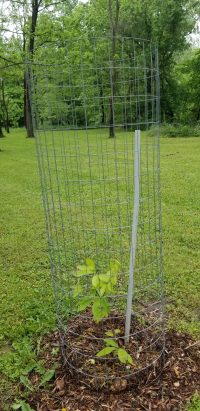
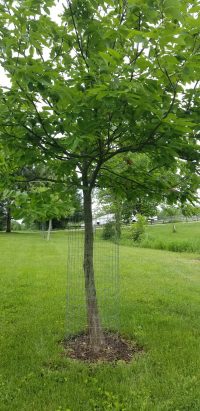 Deer present problems at all stages of tree growth. They browse young trees, bucks rub on slightly older trees, and then deer eat the nuts when they drop. The best protection is an 8-ft high woven wire fence around the orchard, but this is expensive. Young trees can be protected by putting a wire cage around each tree. Considering cost, labor, and efficacy, a good cage can be made by cutting a 4-ft long piece of 5 ft wide 2×4 welded wire. The piece easily forms a 16 in. diameter circle to be placed around the tree and held in place with a metal stake (an old tee-post works well). In 2-3 years, the trees will be above browse height, but the trunks still need protection from buck rubbing, so leave the cage there or use some other means to protect the trunk. Spraying trees with blood from your local butcher shop is an effective repellent for both browsing and buck rubbing, but it has to be applied 3 times per year. Chestnut trees tend to be branchy and the branches are somewhat of a deterrent to buck rubbing, so do not prune the trees and expose long, bare stems. Many people use plastic tree shelters, but shelters stunt growth, cause spindly stems, and often attract and harbor voles which can kill the trees.
Deer present problems at all stages of tree growth. They browse young trees, bucks rub on slightly older trees, and then deer eat the nuts when they drop. The best protection is an 8-ft high woven wire fence around the orchard, but this is expensive. Young trees can be protected by putting a wire cage around each tree. Considering cost, labor, and efficacy, a good cage can be made by cutting a 4-ft long piece of 5 ft wide 2×4 welded wire. The piece easily forms a 16 in. diameter circle to be placed around the tree and held in place with a metal stake (an old tee-post works well). In 2-3 years, the trees will be above browse height, but the trunks still need protection from buck rubbing, so leave the cage there or use some other means to protect the trunk. Spraying trees with blood from your local butcher shop is an effective repellent for both browsing and buck rubbing, but it has to be applied 3 times per year. Chestnut trees tend to be branchy and the branches are somewhat of a deterrent to buck rubbing, so do not prune the trees and expose long, bare stems. Many people use plastic tree shelters, but shelters stunt growth, cause spindly stems, and often attract and harbor voles which can kill the trees.
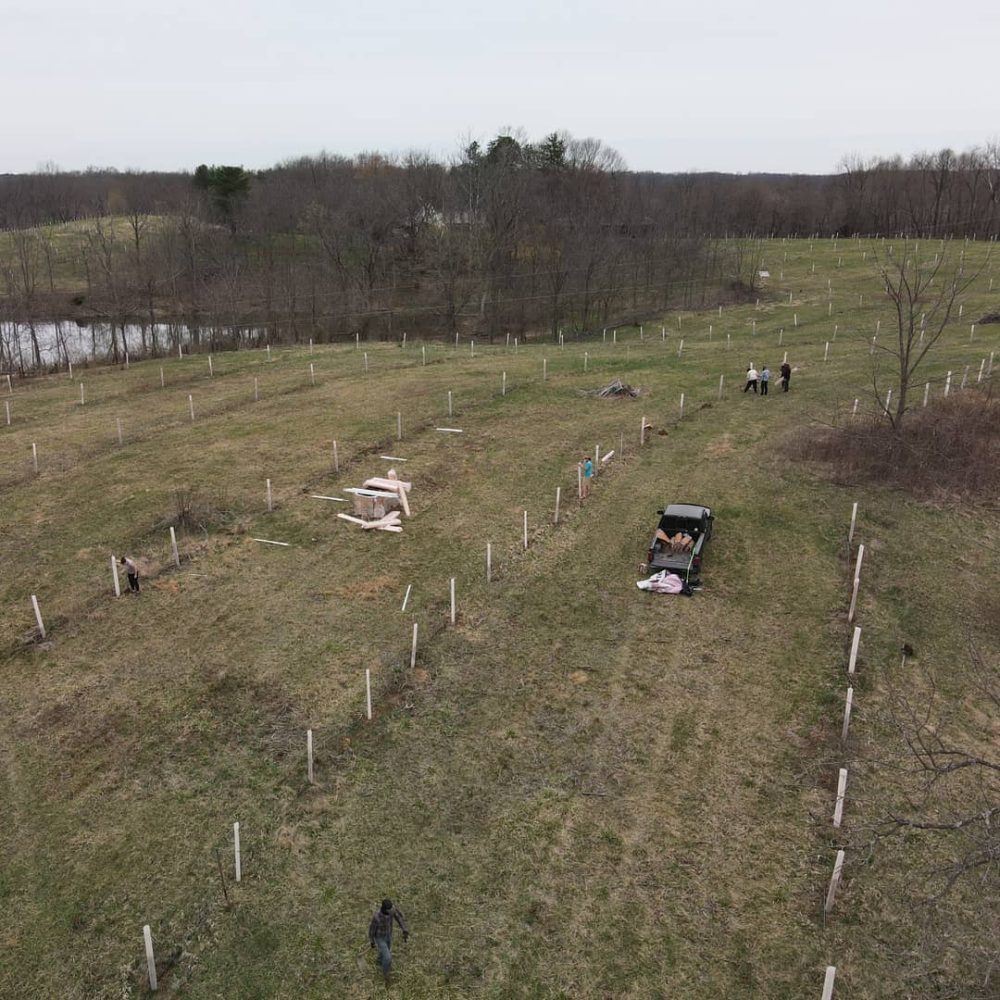 At maturity Chinese chestnuts will fully occupy the land at a spacing of 40 X 40 ft (or even wider), but it takes up to 20 years to reach full occupation at this spacing. If trees are planted too close, mutual shading causes a reduction in yield. The best practice is to plant trees close initially and then thin them as they grow and begin to crowd each other. The minimum spacing for starting a planting is 15 X 20 ft. Trees should be planted on a rectangular grid to facilitate mowing and spraying. Harvest-worthy production should begin at age 5 or 6. Thinning of closely spaced trees is a several-year process that begins at age 8 to 10. Poorer performing trees are removed first. Ultimately, trees end up at a spacing that allows about 800 to 1600 sq ft per tree (25 to 50 trees per acre). Branches will grow to fill gaps in the planting even if spacing varies in different directions. Close initial spacing does provide more early production, which more than pays for the extra trees and their removal. An alternative to close spacing is moderately wide initial spacing such as 20 X 40 ft. This spacing creates permanent 40 ft aisles that allow easy mowing, spraying, and mechanical harvesting; and they admit enough light that trees within the rows (20 ft spacing) do not necessarily have to be removed to alleviate crowding. However, up to half of the trees can be removed, as a means to eliminate poorly performing trees while their better-performing neighbors take over their space. In summary, close spacing will result in higher early returns while wider spacing requires less work and decision-making during the early production years. Close spacing requires making decisions early in the life of the orchard regarding which are the best and it requires removal of some good trees just as they are increasing their production. A closely spaced orchard will reach full production in about 15 years while a widely-spaced orchard will require about 20 years. Chestnut trees live and remain productive for more than 50 years.
At maturity Chinese chestnuts will fully occupy the land at a spacing of 40 X 40 ft (or even wider), but it takes up to 20 years to reach full occupation at this spacing. If trees are planted too close, mutual shading causes a reduction in yield. The best practice is to plant trees close initially and then thin them as they grow and begin to crowd each other. The minimum spacing for starting a planting is 15 X 20 ft. Trees should be planted on a rectangular grid to facilitate mowing and spraying. Harvest-worthy production should begin at age 5 or 6. Thinning of closely spaced trees is a several-year process that begins at age 8 to 10. Poorer performing trees are removed first. Ultimately, trees end up at a spacing that allows about 800 to 1600 sq ft per tree (25 to 50 trees per acre). Branches will grow to fill gaps in the planting even if spacing varies in different directions. Close initial spacing does provide more early production, which more than pays for the extra trees and their removal. An alternative to close spacing is moderately wide initial spacing such as 20 X 40 ft. This spacing creates permanent 40 ft aisles that allow easy mowing, spraying, and mechanical harvesting; and they admit enough light that trees within the rows (20 ft spacing) do not necessarily have to be removed to alleviate crowding. However, up to half of the trees can be removed, as a means to eliminate poorly performing trees while their better-performing neighbors take over their space. In summary, close spacing will result in higher early returns while wider spacing requires less work and decision-making during the early production years. Close spacing requires making decisions early in the life of the orchard regarding which are the best and it requires removal of some good trees just as they are increasing their production. A closely spaced orchard will reach full production in about 15 years while a widely-spaced orchard will require about 20 years. Chestnut trees live and remain productive for more than 50 years.
Unlike most fruit trees, chestnuts don’t require a great deal of pruning. Young Chinese chestnut trees tend to be branchy and sprawling and it is tempting to try to shape them up into a straight, upright tree. However, the less they are pruned, the quicker they will come into production. After they begin production, lower branches and multiple stems should be gradually removed to allow mowing and harvesting. Most of the production is on the tips of vigorous shoots, so the tops of the trees are not pruned. Branches need to be in full sun in order to be productive. As trees fill their spaces in the orchard, large branches should be removed to let sunlight in.
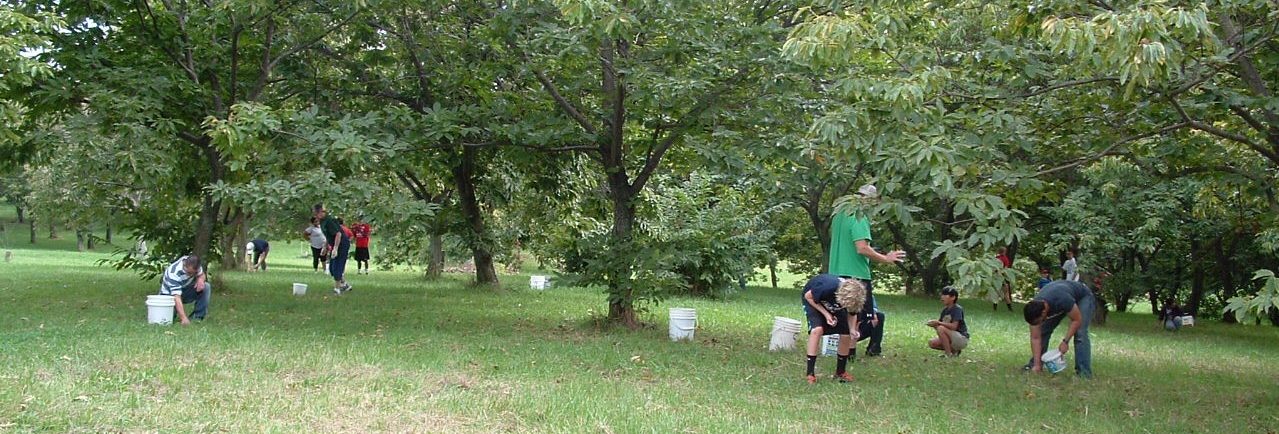 Generally, chestnuts are allowed to naturally drop from the trees when they are ripe and then they are picked up, usually by hand. At the present time, good harvesting machines don’t exist that work on wet, sloping conditions. However, good mechanical harvesting systems are being developed and will be essential for the future.
Generally, chestnuts are allowed to naturally drop from the trees when they are ripe and then they are picked up, usually by hand. At the present time, good harvesting machines don’t exist that work on wet, sloping conditions. However, good mechanical harvesting systems are being developed and will be essential for the future.
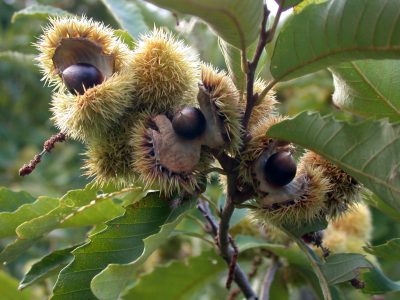 Chestnuts drop over several weeks in September and October and must be harvested within a few days after they drop because of their perishability. Since chestnuts are 50% water they need to be promptly harvested before they dry out. Under warm, dry conditions chestnuts should not lie on the ground for more than a day or two. On the other hand, if it’s cool and wet (rainy), there is no harm in letting the chestnuts lie in the orchard, except that they are subject to wildlife depredation. On a given tree, chestnuts will drop over a period of several days to a week or more. The main marketing season is October and November.
Chestnuts drop over several weeks in September and October and must be harvested within a few days after they drop because of their perishability. Since chestnuts are 50% water they need to be promptly harvested before they dry out. Under warm, dry conditions chestnuts should not lie on the ground for more than a day or two. On the other hand, if it’s cool and wet (rainy), there is no harm in letting the chestnuts lie in the orchard, except that they are subject to wildlife depredation. On a given tree, chestnuts will drop over a period of several days to a week or more. The main marketing season is October and November.
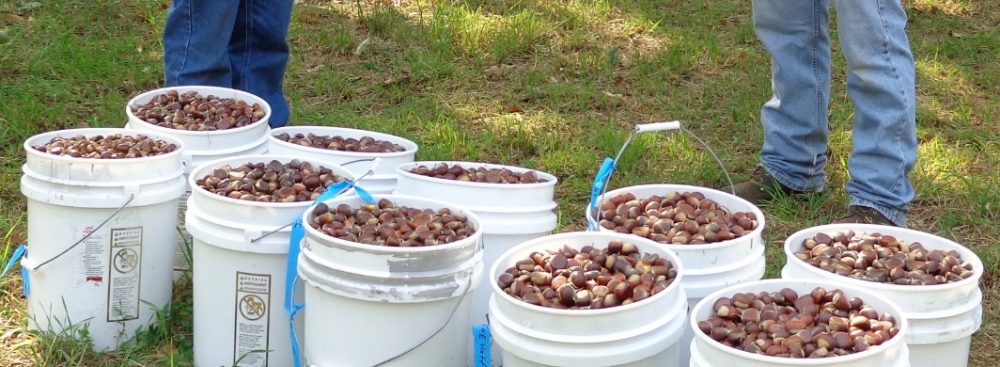 Presently, most chestnuts are marketed fresh, in-shell, shortly after harvest up through the holidays. Most growers bag them and sell directly to consumers through a farm market or website. Some growers sell them as a pick-your-own crop. Larger growers wholesale their crop. Demand is high; buyers often seek out growers. After harvest but before sale, chestnuts need to be cleaned, optionally sized, graded (remove bad nuts), bagged, and stored under refrigeration. Postharvest handling, storage, and marketing involve significant costs. There is a small, but growing interest in peeled kernels, especially dried peeled kernels that can be milled into flour or used for other products. Making chestnut kernel products involves a substantial investment in processing equipment, and thus requires a large volume of chestnuts for economic viability.
Presently, most chestnuts are marketed fresh, in-shell, shortly after harvest up through the holidays. Most growers bag them and sell directly to consumers through a farm market or website. Some growers sell them as a pick-your-own crop. Larger growers wholesale their crop. Demand is high; buyers often seek out growers. After harvest but before sale, chestnuts need to be cleaned, optionally sized, graded (remove bad nuts), bagged, and stored under refrigeration. Postharvest handling, storage, and marketing involve significant costs. There is a small, but growing interest in peeled kernels, especially dried peeled kernels that can be milled into flour or used for other products. Making chestnut kernel products involves a substantial investment in processing equipment, and thus requires a large volume of chestnuts for economic viability.
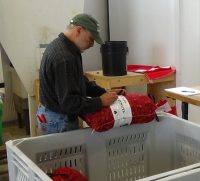 Even though chestnuts have been cultivated for thousands of years in Europe and Asia, a large, commercial industry has not yet developed in the USA. Consequently, plant materials and cultural practices have not been established and researched. Economic, pricing and marketing information is elusive and variable. The industry is in a pioneering stage of development. Many fundamental questions remain unsettled. Conflicting and confusing information abounds. There is not much university support (but we appreciate that which does exist!). A chestnut grower needs to be someone who enjoys the pioneering aspect of the business and is comfortable with unknowns, surprises, and discovery. Chestnut growing is a long-term endeavor. Putting a chestnut orchard in the ground is a commitment of more than 25 years and, if successful, is a trans-generational operation. There is a need for substantial up-front investment and break-even is more than 10 years out. On the bright side, the past 30 years have seen substantial gains in all aspects of the industry. The industry is small, but growing rapidly, and some growers are making money. But most chestnut growers are not in it just for the money: chestnut trees are good for the land and chestnuts are good food for those who eat them.
Even though chestnuts have been cultivated for thousands of years in Europe and Asia, a large, commercial industry has not yet developed in the USA. Consequently, plant materials and cultural practices have not been established and researched. Economic, pricing and marketing information is elusive and variable. The industry is in a pioneering stage of development. Many fundamental questions remain unsettled. Conflicting and confusing information abounds. There is not much university support (but we appreciate that which does exist!). A chestnut grower needs to be someone who enjoys the pioneering aspect of the business and is comfortable with unknowns, surprises, and discovery. Chestnut growing is a long-term endeavor. Putting a chestnut orchard in the ground is a commitment of more than 25 years and, if successful, is a trans-generational operation. There is a need for substantial up-front investment and break-even is more than 10 years out. On the bright side, the past 30 years have seen substantial gains in all aspects of the industry. The industry is small, but growing rapidly, and some growers are making money. But most chestnut growers are not in it just for the money: chestnut trees are good for the land and chestnuts are good food for those who eat them.
Chestnut weevils are a big problem. These insects lay eggs in maturing chestnuts that result in “wormy” chestnuts that are unsalable. Chestnut weevils are controlled by spraying, sanitation, and hot water treatment of harvested chestnuts. Controlling chestnut weevils is a major consideration before deciding to plant chestnut trees.
Asian chestnut gall wasp is an introduced pest. They make galls on young shoots as shoot growth commences in spring. Damage to the trees can be severe for several years before biological controls spontaneously reduce or eliminate this pest. There are no chemical control methods that work. Gall wasps do not affect nut quality. In areas where gall wasps are long established, they seem to be more-or-less in equilibrium with bio-controls and become a minor pest.
Blossom end rot is a disease that causes a black decay of the blossom (pointy) end of chestnut kernels. It can become a serious problem, affecting 5 to 40% of the crop. For many growers BER has recently become a major problem; it is not known why now and not in the past. Chemical control measures have not yet been developed.
Root diseases such as phytophthora root rot can be deadly to chestnuts, esp to American chestnuts and chinkapins. However, these diseases are less of a problem on well-drained soils, less of a problem in areas where the ground freezes in winter, and less of a problem on Chinese and Japanese chestnuts, which display substantial resistance. Phytophthora root rot and other root diseases are the main reason that chestnuts will not survive on wet or heavy soils.
Chestnut blight is a serious bark disease (canker disease) caused by a fungus (Cryphonectria parasitica) that is deadly to American chestnuts and slightly less severe on chinkapins and European chestnuts. Chinese chestnuts and Japanese chestnuts carry resistance to this disease, but there is genetic variation in resistance. Growing resistant trees is the only practical control.
Leaf eaters such as Japanese beetles, caterpillars, and Asiatic oak weevils can sometimes cause serious defoliation and warrant control. Most of the time, though, these pests just do minor damage and can be ignored.
